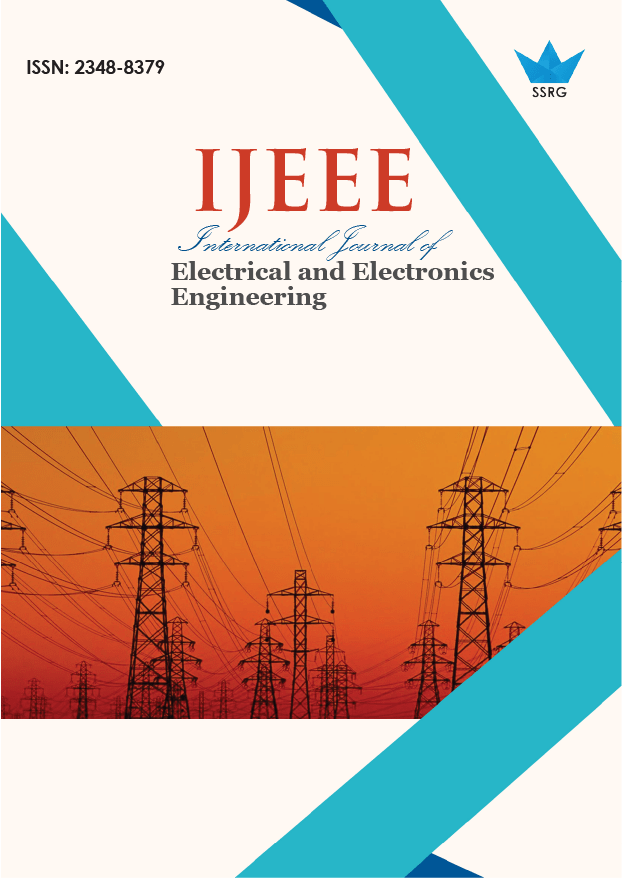Step-Up Multi-input DC–DC Converter for Hybrid Electric Vehicles Application

| International Journal of Electrical and Electronics Engineering |
| © 2020 by SSRG - IJEEE Journal |
| Volume 7 Issue 7 |
| Year of Publication : 2020 |
| Authors : Snehal Uphade, V.R Aranke |
How to Cite?
Snehal Uphade, V.R Aranke, "Step-Up Multi-input DC–DC Converter for Hybrid Electric Vehicles Application," SSRG International Journal of Electrical and Electronics Engineering, vol. 7, no. 7, pp. 35-40, 2020. Crossref, https://doi.org/10.14445/23488379/IJEEE-V7I7P106
Abstract:
A multi input bidirectional DC-DC converter (MIBC) is proposed to integrate various DC sources with different voltage levels with bidirectional power flow capability. The structure of multi input bidirectional DC-DC converter simpler to design compare with single input converters. The FC is considered as the main power supply, and roof-top PV is employed to charge the battery, increase the efficiency, and reduce fuel economy. The converter has the capability of providing the demanded power by load in absence of one or two resources. The voltage from the photo voltaic(PV) cells is fed to the cuk converter to step up the voltage before feeding to inverter providing the power to propulsion of three phase induction motor. The multi input bidirectional
converter can deal with ultra-capacitor and battery individually or simultaneously with proper control mechanism. The proposed circuit is validated through the simulation results presented in the paper.
Keywords:
Hybrid Electric Vehicle, DC-DC Converter, ultra-capacitor etc
References:
[1] H. J. Chiu and L. W. Lin, “A bidirectional dc-dc converter for fuel cell electric vehicle driving system,” IEEE Trans. Power Electron., vol. 21, o. 4, pp. 950–958, Jul. 2006.
[2] T. Markel, M. Zolot, K. B. Wipke, and A. A. Pesaran, “Energy storage requirements for hybrid fuel cell vehicles,” presented at the Adv. Autom. Battery Conf., Nice, France, 2003.
[3] S.Miaosen, “Z-source inverter design, analysis, and its application in fuel cell vehicles,” Ph.D. dissertation, Dept. Electr. Comput. Eng., Michigan State Univ., East Lansing, MI, USA, 2007.
[4] O. Hegazy, R. Barrero, J. Van Mierlo, P.Lataire, N. Omar, and T. Coosemans, “An advanced power electronics interface for electric vehicles Applications,” IEEE Trans. Power Electron., vol. 28, no. 12, pp. 1–14, Dec. 2013.
[5] M. R. Feyzi, S. A. KH. Mozaffari Niapour, F. Nejabatkhah, S. Danyali, and A. Feizi, “Brushless DC motor drive based on multi-input DC boost converter supplemented hybrid PV/FC/Battery power system,” in Proc. IEEE Electr. Comput. Eng. Conf., 2011, pp. 000442–000446.
[6] R. J. Wai, C. Y. Lin, and B. H. Chen, “High-efficiency DC–DC converter with two input power sources,” IEEE Trans. Power Electron., vol. 27, no. 4, pp. 1862–1875, Apr. 2012.
[7] L. J. Chien, C. C. Chen, J. F. Chen, and Y. P. Hsieh, “Novel three-port converter with high-voltage gain,” IEEE Trans. Power Electron., vol. 29, no. 9, pp. 4693–4703, Sep. 2014.
[8] M. Koot, J. Kessels, B. de Jager, W. Heemels, P. Van den Bosch, and M. Steinbuch, “Energy management strategies for vehicular electric power systems,” IEEE Trans. Veh. Technol., vol. 54, no. 3, pp. 771–782, May 2005.
[9] F. Nejabatkhah, S. Danyali, S. H. Hosseini, andM. SabahiNiapour, “Modeling and control of a new three-input DC–DC boost converter for hybrid PV/FC/battery power system,” IEEE Trans. Power Electron., vol. 27, no. 5, pp. 2309–2324, May 2012.
[10] L. W. Zhou, B. X. Zhu, and Q. M. Luo, “High step-up converter with capacity of multiple input,” IET Power Electron., vol. 5, no. 5, pp. 524–531, May 2012.
[11] A. Ajami, H. Ardi, and A. Farakhor, “A novel high step-up DC/DC converter based on integrating coupled inductor and switched-capacitor techniques for renewable energy applications,” IEEE Trans. Power Electron., vol. 30, no. 8, pp. 4255–4263, Aug. 2015.
[12] H. Ardi, R. R.Ahrabi, and S.N. Ravandanegh, “Nonisolated bidirectional DC–DC converter analysis and implementation,” IET Power Electron., vol. 7, no. 12, pp. 3033–3044, Jun. 2014.
[13] Vinay k m, Isaac Raju "Hybrid Electric Vehicles", International Journal of Engineering Trends and Technology (IJETT), V50(2),2017

 10.14445/23488379/IJEEE-V7I7P106
10.14445/23488379/IJEEE-V7I7P106